#dalit rights
Text
"INDIA IS NOT CASTEIST ANYMORE BECAUSE OUR PRIME MINISTER AND PRESIDENT ARE NOT UPPER CASTE!"
So sick of constantly seeing this take. The USA had a black president for 8 years. Did that make racism magically vanish from the country? Just shut the fuck up
#india#casteism#desiblr#desi tag#desi tumblr#desi#desi stuff#original post#not incorrect quotes#caste violence#dalit#dalit rights#hindublr#hindu#hinduism
170 notes
·
View notes
Text

#dalit#dalit rights#communism#socialism#anti capitalism#twitter post#anarchy#leftism#leftists#leftist#leftist politics#leftist propaganda#left wing#anarchist#india#rip twitter#indian#hinduism#hindublr#hindusim#lord shiva#sanatandharma#bharat
21 notes
·
View notes
Text

Mahasweta Devi, inaugural speech at the Frankfurt Book Fair on the occasion of India becoming the first country to be invited as the chief guest for the second time, 2006.
text id: [ …my country; torn, tattered, proud, beautiful, hot, humid, cold, sandy, shining India. My country. ]
#mahasweta devi#desi tumblr#desi academia#nerd stuff#poetry tumblr#desi culture#literature#desi literature#dalit rights#adivasi#india#indian#booksbooksbooks#social activism#human rights#women's rights#labor rights
8 notes
·
View notes
Text
Social Justice Warrior: Thanthai Periyar’s Struggle for All-India OBC, SC, and ST Reservation in Education | History behind Social Justice Day — Rational Sapien.
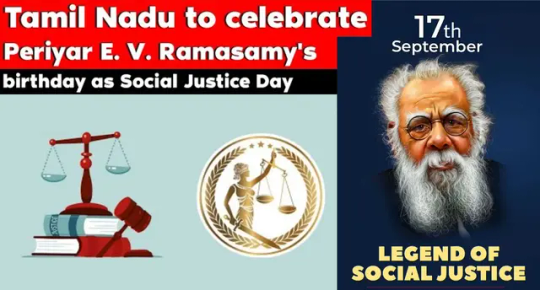
Thanthai Periyar, also known as E. V. Ramasamy, was born to a wealthy merchant in Erode and lived in opulence. In his early days, he was attached to the Indian National Congress and the Khadi movement. He carried Khadi clothes on the streets and sold them, and moved his family to a simpler life.
As a nationalistic Congress leader, Periyar carried bundles of Khadi clothes on his shoulders with the hope of bringing social justice alive. He focused on passing a bill on “Communal Representation” to ensure fair representation for non-Brahmins in government and other institutions. He carried copies of the bill in his hands for five consecutive Congress conferences.
However, due to the heavy Brahmin dominance in the party, his bill was not passed. Instead, the Brahmins twisted his “Community based Representation Bill” as a form of “Divisive communalism”. Periyar realized that the Congress movement was the “fort of Brahminical supremacists.”
Periyar was a powerful and wealthy man, but he gave up everything to fight for social justice. He resigned from his 26 positions, including that of Erode City Council president, to join the Congress party. Later, when he realized that the Congress was not committed to social justice, he left the party in 1925. He said, “If the nation was liberated without social justice, it would only benefit the dominant caste (Brahmins).”

Rettaimalai Srinivasan (left), Justice Party leaders - P. Theyagarayar & Dr. T.M Nair, Periyar ( DK @ Dravidar kazhagam), Arignar Anna ( Dravidar Munnetra Kahzagam @ DMK)
During British rule in the 19th century, Brahmins dominated all fields. The fight for caste-based reservation has a long history, starting with Ayothidasa Pandithar’s call for non-Brahmins to have the right to employment in 1891, and continuing with the Justice Party in 1916.
The Justice Party pioneered social justice in South India by implementing reservation for non-Brahmin communities in 1916. This paved the way for inclusive growth. Brahmins claimed that giving equal representation to all communities was “divisive communalism” to maintain their own power and privilege.
The Justice Party came to power with the support of the people and the Council of Ministers led by King Panagal presented the bill in the Legislative Assembly in August 1921. This draft law was notified as a Government Ordinance Communal G.O 613 (16.9.1921) and a committee consisting of legislators was constituted to monitor the proper implementation of the Ordinance.
After this, on August 15, 1922, an ordinance was promulgated to provide class representation in educational institutions, but this ordinance was stalled due to the conspiracy of the Brahmins. The fact that what happened on that day was the lack of support from the governor and the white ICS officials. Hindu, Sudeshamitra etc. Brahmins wrote strongly against it.
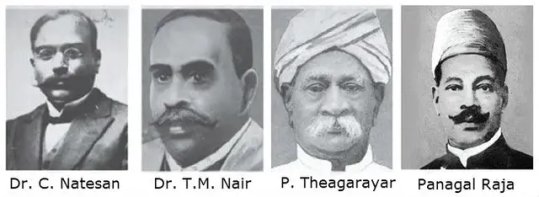
Justice Party Leaders
The Justice Party lost the third election in 1926. There was a dispute among the majority Swarajya Party over who would be the Chief Minister. Therefore, the Swarajya Party brought P. Subbarayan from the Justice Party and asked him to form an independent cabinet so that the Justice Party should not form the cabinet. Similarly, he formed a cabinet with himself as the Chief Minister and Swarajya Party member A. Ranganatha Mudaliar and RN Arokiasamy Mudaliar as ministers and took over the government on 4.12.1926. The Swarajya Party dreamed of winning Subbarayan away from the Justice Party and bringing it to their side. However, he also led the government after listening to the Justice Panagal, who was the leader of the opposition party. Therefore, his regime is considered as a Justice Party regime.
Suppurayan, a former Justice Party member, was supported by both the Swarajya Party and the Congress Party, but Suppurayan took office as Chief Minister in August 1927 when he moved a motion of no confidence in the Subpurayan cabinet, which was defeated with the support of 14 members of the Justice Party.

Paramasivam Suppurayan, a former Justice Party member successfully implemented Communal G.O with the help of Justice Party in 1928.
S. Muttiah Mudaliar left the Congress party opposing the Congress’s pro-brahmin activites and join the Suppurayan cabinet. He was the first to introduce the new Caste Reservation Act in the Madras Provincial Assembly on 04.11.1927. The Suppurayan Cabinet issued a new order for caste reservation in 1927 (G.O. M.S. No 1021).
On January 28, 1928, Subparayan did not accept the resolution passed by the Swarajya Party in the Legislative Assembly to ignore the Simon Commission. So two ministers belonging to the Swarajya Party resigned and therefore got the support of the Justice Party Suppurayan became Ministers in his cabinet S. Muthiah Mudaliar and MR Sethuratnam Iyer. Justice Party and Self-Respect Movement as their commander Soundarapandian came to the Suppurayan cabinet as the whip of the ruling party. Soundarapandian built this cabinet like a fortress.
This cabinet came into charge on 16 March 1928. This cabinet is also considered as the Justice Party cabinet.
This Cabinet passed Communal Ordinance №744, dated 13.9.1928. This order issued by S. Muthiah Mudaliar for the first time defined this number of places for all the communities. Yes, S. Muthiah Mudaliar, a non-Brahmin, issued this “Community based Reservation for all Government jobs” in 1928 providing 100% reservation for the entire population, including Brahmins, non-Brahmins, and minorities.

Community Based Reservation implemented by Suppurayan Devised by Justice Party in 1926.
After the implementation, Periyar pointed out some of the issues in the Communal Go G.O. M.S. No 1021.
Minister S. Muthiah Mudaliar brought this Communal Ordinance for the Registration Department he was holding. But, Periyar wrote in the “Kudiarasu” that communal representation should be implemented in all sectors. Accepting Periyar’s order, the Subbarayan cabinet issued this order in other departments as well. By these orders, non-Brahmins got reservation in government jobs. Thus Periyar enriched communal representation. Periyar praised this as “long live Muthiya Mudaliyar!” in Kudiarasu Editorial Magazine.
Periyar’s campaign progressed by demolishing the Brahminical structure by exposing the Brahmins’ conspiracy in his editorials and articles in the Kudi Arasu newspaper. Thanthai Periyar used his power and authority in the Madras province to educate all non-Brahmin communities about the true purpose of community-based reservation.
People who say that Periyar wasn’t important for social justice don’t understand how he changed people’s minds.
Periyar started the Self-Respect Movement in 1925, the same year as the Indian National Congress. He worked hard to expose the harmful structures of these systems to the people.He played a big role in social justice because of the ways he showed people how caste, religion, piety, superstitions, misogyny, ritualism, and formalism were harmful and kept people from respecting themselves.
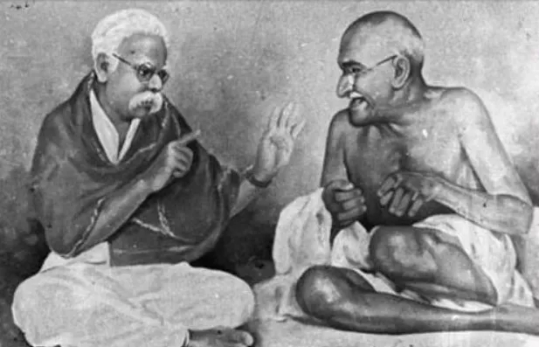
Periyar Left congress & Started Self Respect movement in 1925.
Periyar didn’t just go to public meetings but also to caste groups meetings. He spoke at caste conferences. Talking to caste groups is like handling a double edged knife But Periyar handled it tactfully. Periyar made miracles by changing the caste mindset into an egalitarian mindset and asking for the rights due to their caste.
Beginning in 1925, he addressed more than ten caste conferences covering the majority of the population. In particular, the conferences of castes like Nadar, Sengundar, Vanniya Kula Chatriyas, Chettiars, Pallars and Adi Dravidians are included in it.”
A caste conference should be convened to take the shortcomings of each caste to the government. If you call me to caste conferences, I will talk about everything and Caste annihilation. He was the one who said that the cruelty of one being superior and one being inferior taught by the Varnashrama Dharma should be eradicated.
He also expressed the shame of having caste Pride. At the same time, he also spoke for rights that were denied in the name of caste. He brought egalitarianism and social justice rights so subtly in the People’s Forum.
After India’s independence, Periyar held caste abolition conferences in a political environment where people developed caste pride out of greed for position and power. Periyar always talked about social justice rights at all conferences, no matter whether they were caste Group conferences or caste abolition conferences.
The Justice Party was able to bring about social change by implementing community-based reservation under British rule through dual rule system. Even after Justice Party, this system of reservation continued till 1950.
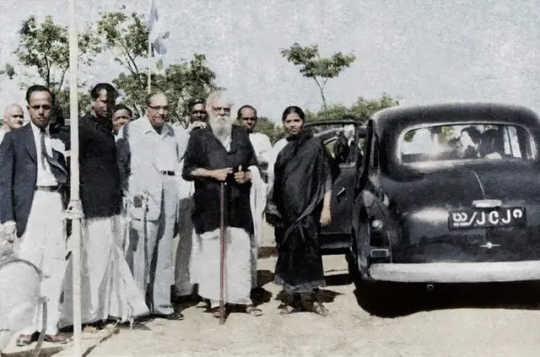
Babasaheb Ambedkar & Thanthai Periyar E V Ramasamy
The Constitution enacted on January 26, 1950, by the intellectual revolutionary Ambedkar, provided for reservation in employment only, but there was no reservation in education. After Independence, Brahminism made its first major attack on social justice brought by Justice party.
It was then that the greed of the brahmins made them gobble up the reservation reserved for the brahmins themselves. Sembagam Durairajan and Srinivasan case played a major role in that. They said “Both of them didn’t get seats in medical college and engineering college respectively”. They filed a case in the Madras court claiming that this was against the fundamental provisions of the Constitution.
After hearing the case of these two, the court found that “Sembagam Durairajan did not apply to the medical college and Srinivasan falsely reported that he did not get a seat even after 14.29% of the reserved engineering seats for Brahmins were filled.” Through their Greediness, the wish of the Brahmins was fulfilled. On 27.07.1950, The Madras High Court struck down the Madras Province’s “Community-based Reservation Rights Act in Education and Employment” Act, which was in implementation from 1924 to 1950, as unconstitutional. The Supreme Court also gave the same verdict.
How will Periyar, as a man who threw away his prosperous life and positions in Congress fighting for the right of social justice for all oppressed castes, accept this verdict?.
14th August in 1950, Periyar launched agitation and gave the clarion call to the people of Tamil Nadu to express protest by declaring “Communal Reservation Day”. The protest was against the judgment given by Supreme Court of India that stayed the Communal Reservation Policy implemented in Madras Presidency right from 1928. On 07.08.1950 at Robinson Park, Chennai, 50,000 people attended the meeting and Periyar invited people from all walks of life to fight.
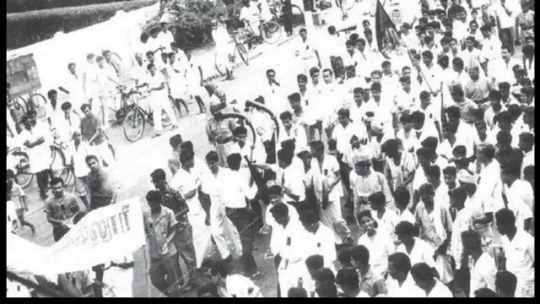
Chennai Pachaiyappa’s College Students joined the protest with Periyar.
On 14th August (1950), Accepting Periyar’s invitation, various students staged a protest. Students of Chennai Pachaiyappa’s College protested against the court order. Periyar’s Call ignited Total agitation in Tamil Nadu in all sectors and all sections of people including students, teachers, doctors, govt. servants, all non-brahmins joined the struggle.
The slogans of “Abolish the political law, want communal rights” chanted by the entire gathering echoed up to the Delhi Union government.
On December 3, 1950, in Trichy, Periyar gathered all-party communal rights supporters including Perarignar Anna (DMK), Kamarajar, and convened a communal conference at Periyar House. He conducted a conference and said, “You have given four water pipes with taps to the streets; but you have not given the water supply to that tank! We have been given reservation for employment, but we have not studied yet. Then, how can we go for job opportunities?”. Periyar passed the Communal G.O.
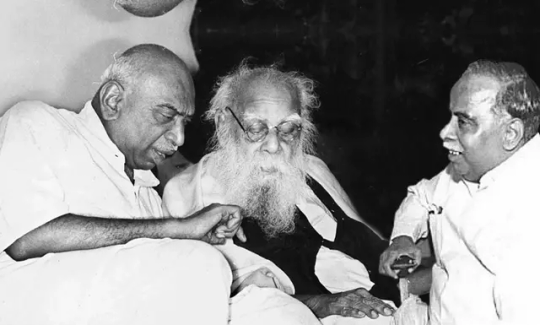
Kamarajar (Left), Thanthai Periyar (center), Perarignar Anna (right).
Tamil Nadu registered its protest that students are protesting and shutting down shops everywhere in Tamil Nadu. They protested by showing black flag to Union Ministers. On the other hand, Kamaraj and Sardar Vallabhbhai Patel conveyed the Seriousness & strength of Periyar’s Protest to the the Prime Minister of the India, Jawaharlal Nehru. Ambedkar also registered his opposition.
Periyar’s voice spread not only to the ears of the Delhi Union government but also to the people about the necessity of reservation in education. Periyar’s agitation forced the Nehru government to come down on education reservation.
The first amendment was tabled in Parliament by Chief Minister Pandit Jawaharlal Nehru on 10.05.1951. Including Education reservation, a total of 14 amendments were made in the Constitution through a single proposal. Nehru mentioned this in his introductory speech on the amendment. “Protests in Madras province lead us to amend the law”. Parliament passed it on 18.05.1951 with an overwhelming majority and made it law.
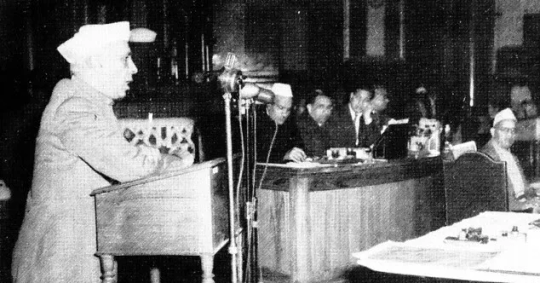
First Constitutional amendment by Chief minister of India, Pandit Jawaharlal Nehru.
In order to overcome the verdict in the Champakam Durai Rajan case, the Parliament brought in the First Amendment Act, 1951 and inserted clause 4 to Article 15. The provisions of this clause are in the nature of an enabling provision (allows, felicitate) and do not impose any obligation on the State to take any special action under it. It merely confers discretion to act if necessary by way of making special provisions for socially and educationally backward class and Scheduled Castes and Scheduled Tribes.
Article 15(4) : “neither clause of this Article 15 nor Clause 2 of Article 29 shall prohibit the State from making any special provision for the advancement of any citizen of socially and educationally backward classes or of Scheduled Castes and Tribes”
Until then, Article 16(4) ensured reservation only in case of employment. Reservation in education came only after the First Amendment, which ensured reservation for backward, scheduled, and minority communities across the country by the Union and State Governments. Through the efforts of Periyar and the DMK, the addition of Section 15(4) to the Indian Constitution paved the way for the Mandal Commission protests by periyarists and the implementation of all-India OBC reservation in education by V.P. Singh.
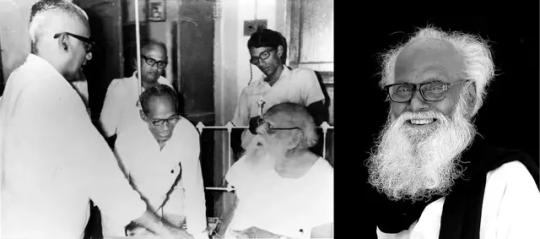
V Anaimuthu (centre) receives permission from Periyar to publish his thoughts.
When Periyar passed away in 1973, Anaimuthu, A periyarist, continued the struggle for social justice of backward classes. Anaimuthu parted ways with the D.K and formed the Periyar Sama Urimai Kazhagam (Periyar Equal Rights Kazhagam) which took up reservation as their main agenda. Between 1976 and 1982, Anaimuthu conducted his campaign for reservation in education and employment in the Central government. In Bihar, their volunteers filled the prison as part of this demand. He took the struggle to New Delhi. The Mandal Commission was formed because of these pressures.
Anaimuthu made sure the Mandal Report was released in Parliament in 1980, thanks to which 50 per cent reservation for the Backward Classes was passed. But it was not implemented as promised, hence he began to meet Members of Parliament from 1981 onwards. In 1990, the then Prime Minister V P Singh announced in the Parliament that the recommendations of the Mandal Commission would be implemented Which provides 27% reservation for OBC’s on top of 23% reservation for SC and ST in India.
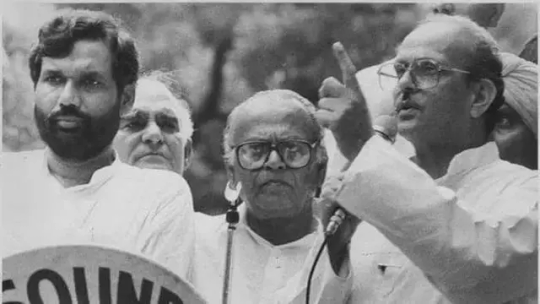
Former Prime Minister V.P. Singh addressing a rally about implementation of the Mandal Commission Report in August 1990
Indira Sawney challenged the Mandal Commission and government decision to implement the OBC Reservation by V.P.Singh in the Supreme Court. In 1992, All India OBC reservation was implemented after Indira Sawney case was Closed with a provision that maximum reservation can be 50% of the educational seats or job vacancies and creamy layer of income of ₹8 lakhs per year. Anaimuthu’s untiring effort to implement the Mandal Commission report in this decade is a milestone in Indian history.
There are so many leaders who have made the government realize the right of social justice. But Periyar was the foremost among the leaders who spread the importance of Social Justice through reservation to the people and even today his followers ensure the
Periyar was a tireless advocate for the rights of the oppressed and backward people in the People’s Forum, touring all the nooks and corners of Tamil Nadu to the extent that he gave up his elite life. People say, “There was no place in Tamil Nadu where Periyar did not set his feet.” Periyar was an uncompromising opponent of the Brahminical intrigue against social justice reservation in the political arena. Social justice is the tool that Periyar used in his political arms to pave those paths against Brahminical intrigue and restore the social rights of the Tamil Nadu. Calling the social justice hero Thanthai Periyar’s birthday as Social Justice Day is a small thank-you to him for his lifelong struggles for the majority oppressed castes.
“One comes to school for training to acquire merit and skill. But if you need a qualification and skill even to study and get training, this is foolishness,” said Periyar. The ruling union government is keeping the meritorious children of our children by imposing merit tests like NEET to protect the power structures of Brahminism. Let us stand on the path of Periyar, who stood for social justice, and take a pledge to eliminate the anti-social justice selection criteria on this Social Justice Day.
#Periyar#Dravidian#Education Reservation#All India OBC SC ST Reservation#E V Ramasamy#First Constitutional Amendment#Indian Educational Reservation#Dalit Rights#Babasaheb Ambedkar
1 note
·
View note
Text

Cover Design for a report for The Inclusivity Project, Dec 2022
1 note
·
View note
Text
#dalitlivesmatter#dalit family#dalit rights#India#United Kingdom#Products for charity#Handmade#Organic Products
1 note
·
View note
Text
about the ongoing hunger strike to ensure that the historic anti-casteism bill passes in california ^^ wanna support?
if you’re on mobile, go to: https://tinyurl.com/Signsb403
other devices, like laptops: https://www.gov.ca.gov/contact/
—
sample email below from the mobile link, not my own writing:
Subject: Please Sign SB403 (Wahab) to End Caste Discrimination
I am writing to request the governor to sign the historic bill SB403 introduced by State Senator Aisha Wahab, which would end discrimination on the basis of caste. This bill aims to clarify existing California state law and make explicit that discrimination based on caste is illegal by adding caste to ancestry and defining caste in the Civil Rights Act, Fair Employment and Housing Act, and Education Code.
Caste systems are social stratification where each position is characterized by hereditary status, endogamy, and social exclusion. Caste discrimination manifests as workplace discrimination, housing discrimination, gender-based violence, and other physical and psychological forms of violence.
Caste discrimination occurs across industries, including technology, construction, restaurants, and domestic work. In these sectors, caste discrimination has included harassment, bias, wage theft, and even trafficking. Caste is today inextricably intertwined with existing legal protections in state and federal civil rights laws such that discrimination based on one’s caste is effectively discrimination based on the intersection of other protected identities. However, because of the grave discrimination caste-oppressed Californians face, these existing protections must be made explicit.
Caste is a workers rights issues, a women's rights issues, and racial justice issue. It is also a bill that has bipartisan support. That is why we are joined by Asian Law Caucus, Stop AAPI Hate, AAPI Equity Alliance, Tech Equity, Equality Labs, Alphabet Workers Union, Ambedkar Association of North America, Asian Pacific American Labor Alliance, AFL-CIO, Californians for Caste Equity, Hindus for Caste Equity, Jakara Movement, South Asian Network, Sikh Coalition, and Sikh American Legal Defense Fund. Every major legal association is in support of caste equity and the lawfulness to make caste equity explicit. This includes the American Bar Association, South Asian Bar Association, National Asian American Pacific Bar Association, and Asian Law Caucus.
That is why we urge you to make history and sign his bill without hesitation. Justice delayed is justice denied. Let's ensure California opportunity for all by ensuring that ancestry and caste discrimination is explicitly prohibited and make history across the country.
Thank You,
[Name]
—
and if you don’t know what caste is? send in an ask @bfpnola or join our Discord server, link in bio, so we can answer you in real-time!
#reaux speaks#california#united states#caste discrimination#casteism#caste abolition#bipoc#resources#labor#workers rights#intersectional feminism#anti racism#racism#history#india#caste#dalit
129 notes
·
View notes
Text
Genuine question for the upper caste people in desiblr. Why do you think "caste is in the past"? Everytime I have seen someone confidently proclaiming that caste is a problem of a bygone era it is always a UC. You guys don't live our reality. You guys don't know the first thing about what it is like from our side. So why do you feel comfortable speaking for us? Would you like it if a British person were to proclaim that colonialism wasn't actually so bad? No? Then why is it different for us?
#rant#original post#casteism#caste#caste violence#dalit rights#india#not incorrect quotes#desi tumblr#desiblr#desi#desi tag#dalit#british colonialism#colonialism#hindublr#hinduism#hindu
176 notes
·
View notes
Text
also having discussions about caste in liberal circles can be so fucking exhausting especially because the people around me treat it as this Big Hypothetical Situation because they’re all upper caste and it could never happen in THIS day and age meanwhile I’ve directly faced caste based microaggressions by like, fully grown adults when I was 14
#I’m not SC but I do technically qualify for OBC (obviously I’m in a place of privilege where caste does not affect me on a day to day#because I’m relatively economically privileged)#but like if I’ve faced that level of stuff then like people who do NOT have the same privileges as me are obviously dealing with it a LOT#more and in a much more harmful way.#so like fight for Dalit inclusion fight for SC ST OBC rights don’t let people talk shit.#and don’t act like your opinion is worth it’s weight in gold when you’ve never ever had to deal with anything of the sort.#not saying that my opinion is worth more or whatever BC my experience is so limited too but like gain some perspective#indian politics
28 notes
·
View notes
Link
“,,, Patriarchy and caste hierarchy, a structure of authority that has existed for more than 2,000 years, have had a magnified effect on Dalit women.
Dalit women - as well as those from less privileged Shudra families - were forced by landlords into wet nursing and other forms of domestic labour and were vulnerable to sexual assault by men from more privileged castes.
“They turned us into a resource and made use of anything that our bodies could provide, even our milk,” Yellamma said.
Women could not refuse to obey, knowing they risked physical, sexual, verbal and psychological abuse and retribution against their families if they did.
Time and again, those who resist caste oppression have faced brutal consequences. In 2006, after a family resisted having their land taken by members of a more dominant caste, a Dalit mother, her daughter and two sons were paraded naked, raped and murdered in the village of Khairlanji, Maharashtra. Last August, a nine-year-old Dalit boy died after his “upper-caste” schoolteacher allegedly beat him for drinking from the teachers’ earthen pot. ,,,”
10 notes
·
View notes
Quote
Viewed by members of the other castes as “untouchables”, Dalits particularly struggle during disasters, when community members bar them from accessing shared water and sanitation facilities: Since the Hindu religious belief operates on strict lines of purity, there is a belief that a Dalit touching a common water source will “pollute it”. As climate change continues to bring worsening floods, droughts, cyclones and more to India, the government is being called upon to do more to protect against caste-based discrimination. A sweeping study released in September by the National Campaign on Dalit Human Rights warned that “climate apartheid” was likely to hit Dalits and Adivasis the hardest, and outlined “systemic inadequacies and disregard in involving their participation in disaster/drought risk management.” “[Indian] society has its dysfunctionalities, and disaster or any kind of crisis just accelerates these dysfunctionalities,” Sarbjit Sarota, a disaster risk reduction specialist at UNICEF India, said.
Suprakash Majumdar, ‘How India’s caste system keeps Dalits from accessing disaster relief’, New Humanitarian
#New Humanitarian#Suprakash Majumdar#India#Dalits#Hinduism#caste-based discrimination#climate apartheid#National Campaign on Dalit Human Rights#Adivasis#Sarbjit Sarota#UNICEF India
7 notes
·
View notes
Link
In India, 67% of abortions are unsafe. The Indian Rural Health Statistics 2019-20 showed a 70% shortfall in the number of obstetricians and gynaecologists in rural India, where 77% of the country’s Dalits live.
Abortion care and access is more on paper in India; especially for Dalits.
A 2015 study showed that 78% of all abortions that year were conducted outside health facilities. Rihana Mansuri, an activist working in Uttar Pradesh, argues that this disproportionately affects Dalit women, who bear the brunt of unsafe abortion in India.
3 notes
·
View notes
Text
BR Ambedkar: The Architect of Indian Constitution and a Champion of Social Justice
What do you think of BR Ambedkar and his Mahaparinirvan Diwas? Share your thoughts, questions, or comments below. We would love to hear from you.
Today, December 6th, is Mahaparinirvan Diwas, a day of remembrance and tribute to Dr. Bhimrao Ramji Ambedkar, popularly known as Babasaheb Ambedkar. He was a prominent Indian jurist, political leader, philosopher, social reformer, and Buddhist revivalist. He is widely regarded as the architect of the Indian Constitution and a champion of social justice and equality. He dedicated his life to…

View On WordPress
#BR Ambedkar#Buddhism#Chaitya Bhoomi#Dalit rights#equality#Hindu Code Bill#Indian Constitution#Mahaparinirvan Diwas#Reserve Bank of India#social justice
1 note
·
View note
Text
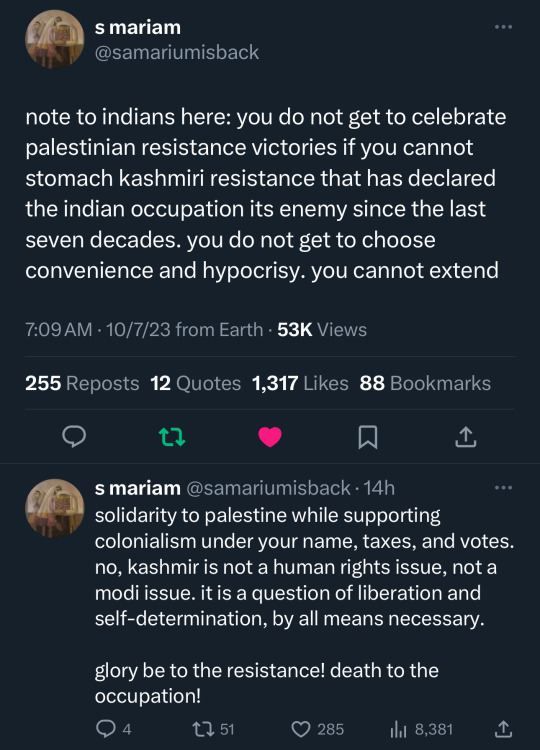
because I am also Indian, I want to also point this out. freedom for colonized people everywhere also means freedom for Kashmiris that are under a brutal Indian occupation. the right to self-determination for all colonized people everywhere, from Palestine to Kashmir to Ireland
a good book to read to learn more about the relationship between Israel and India is “Hostile Homelands” by Azad Essa. India is looking to Israel treatment of Palestinians as a blueprint for its own crimes against Kashmiris, Muslims and Dalits. India is also complicit in furthering Israeli settler colonialism in Palestine - the Port of Haifa is currently partly owned by Adani Ports & SEZ, the founder of which is one of the wealthiest men in India, Gautam Adani (won’t come as a surprise that Adani is also very close to Modi and the BJP)
2K notes
·
View notes
Text

Cover Design for a report (with a photo by me) for The Inclusivity Project, Dec 2022
0 notes
Text
so far, nearly 3 weeks on from the inauguration of ram mandir, indian authorities have demolished as many masjids and/or madrasas.
30.01.24 - akhoonji masjid & madrasa in delhi, also destroying a cemetery, shrine and all the students’ belongings in the process.
01.02.24 - a madrasa in maharashtra despite facing opposition from local muslims and one day before its scheduled court appeal.
08.02.24 - a masjid & madrasa in uttarakhand. this comes one day after uttarakhand became the first state to pass the uniform civil code (x, x) which aims to apply a ‘hindu code’ to all indians, infringing on the rights of dalits, adivasis, sikhs, christians, buddhists and muslims (i.e. anybody non-hindu) to practice their religion/lifestyle. muslim women protesting the demolition were lathi-charged (beaten with sticks) by police, a shoot-on-sight order was given resulting in 6 muslims killed and 300+ injured in the riots that followed, a curfew was put in place during which hindutva mobs burned down muslim homes and businesses while shouting abuse at muslims.
as always, no prior notice was given and bjp used it’s gold-standard excuse for each demolition, citing ‘illegal encroachment’.
in addition to these masjid demolitions, indian authorities bulldozed 2 neighbourhoods (ghettos, really) in the same timeframe and also without prior notice:
01.02.24 - jasola slum, which, having been around for at least 16 years, should not have been demolished without providing alternative housing, as the delhi slum policy states for slums which came up before 2015. obviously, housing hasn’t been provided.
06.02.24 - panchsheel nagar in mumbai which, having been around since 2011, entitled residents to paid rehabilitation, which has also not been given. this has left over 110 families homeless.
the demographic of both neighbourhoods, surprise surprise, is overwhelmingly muslim, buddhist and dalit.
bjp is enjoying the cover it is receiving from israel’s genocide in palestine to do whatever it wants and is getting bolder by the day. this ‘bulldozer justice’ has been happening for years, but not at such a rapid rate as it is now.
#and bjp’s crimes are always underreported or not reported at all in mainstream news anyway#india#m#!
1K notes
·
View notes